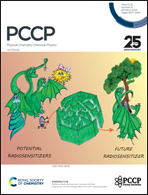Ultra-thin van der Waals magnetic tunnel junction based on monoatomic boron vacancy of hexagonal boron nitride†
Abstract
We present a novel strategy to create a van der Waals-based magnetic tunnel junction (MTJ) comprising a three-atom layer of graphene (Gr) sandwiched with hexagonal boron nitride (hBN) layers by introducing a monoatomic boron vacancy in each hBN layer. The magnetic properties and electronic structure of the system were investigated using density functional theory (DFT) and the transmission probability of the MTJ was investigated using the Landauer–Büttiker formalism within the non-equilibrium Green function method. The Stoner gap was created between the spin-majority channel and the spin-minority channel on the local density of states of the hBN monoatomic boron-vacancy (VB) near the Fermi energy, creating a possible control of the spin valve by considering two magnetic alignment of hBN(VB) layers, anti-parallel configuration (APC) and parallel configuration (PC). The transmission probability calculation results showed a high electron transmission in the PC of the hBN(VB) layers and a low transmission when the APC was considered. A high tunneling magnetoresistance (TMR) ratio of approximately 400% was observed when comparing the APC and PC of the hBN(VB) layers in hBN(VB)/Gr/hBN(VB), giving the highest TMR ratio for the thinnest MTJ system.



 Please wait while we load your content...
Please wait while we load your content...